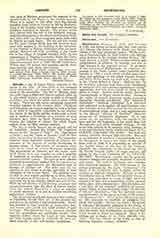

Akominatos, MICHAEL, d. 1215; and NICETAS, d. 1206; also known as CHONIATES, from their native city, Chonia (the Colossae of St. Paul), two famous Greeks of the later Byzantine period. While studying at Constantinople by their father’s wish, Michael acted as tutor to his younger brother Nicetas. Michael became a priest; Nicetas studied history and jurisprudence, in addition to theology, and rose to high honors in the imperial service. As governor of the province of Philippopolis, he witnessed the passage of the Third Crusade under Frederick I (Barbarossa), in 1189, a march which entailed great hardships and sufferings on the whole Eastern Empire, and which Walter Scott has dealt with, incidentally, in his “Count Robert of Paris“. Michael, who, by his brother’s influence, had been made Archbishop of Athens in 1175, had a similar experience of “Latin” aggressions, and was even forced to retire to the island of Chios. Nicetas, with his family, fled from Constantinople to Nicaea, where he died. Nicetas is the author of several important works concerning Byzantine theology and history. His “Treasure of Orthodoxy” (Greek: Thesauros `Orthodoksias) is a historical and polemical work against all anti-Christian heresies, valuable among other reasons for the treatment of contemporary errors, and in a way supplementary to the famous “Armory of Doctrine” (Greek: Panoplia Dogmatike) of Euthymios Zigabenos. It is also prized for its quotations from the synods of his time and for the fragments it has saved from lost Monophysite and other heretical writings. It has never been printed in its entirety; some portions of it are reprinted from earlier editions in Migne (P.G., CXXXIX, 1101-1444; CXL, 9-281). The work was written probably between 1204 and 1210. His fame as an historian of medieval Constantinople rests on his description in twenty-two books of the period from 1180 to 1206; it is practically an account of the fateful reigns of the last of the Comneni, especially the vicissitudes of the royal city during the Fourth Crusade (1204); its siege, capture, and pillage by the Latin Christians (P.G., CXXXIX, 287-1088). Krumbacher vouches for his generally objective temper and equitable treatment of persons and events. The style is bombastic and overladen with rhetorical ornament. His little treatise on the statues destroyed by the Latin “barbarians” (De Signis, P.G., CXXXIX, 287) is highly prized by students of classical antiquities. Michael, of whom Krumbacher says (p. 469) that his tenure of the see of Athens was equivalent to a ray of light amid the obscurity of ages, was a meritorious orator, pastoral writer, poet, and correspondent. His discourses cast a sad light on the wretched conditions of contemporary Attica, as does his iambic elegy “On the City of Athens”, described as “the first and only surviving lamentation for the decay and ruin of the ancient and illustrious city”. Of his letters 180 have reached us. His character is described as energetic, but gentle and upright. He was too much a Byzantine to denounce the imperial authority in the person of the cruel Andronicus, while that monster lived; but after his death, says Krumbacher, he could not find words enough to depict his iniquities. Many of his writings are in Migne (P.G., CXL, 298-384; 124-1258). The best edition of his works is that of Spiridion Lambros (Athens, 1879-80).
THOMAS J. SHAHAN

